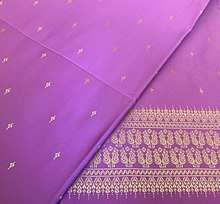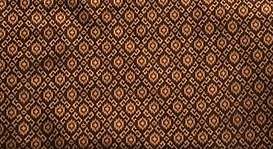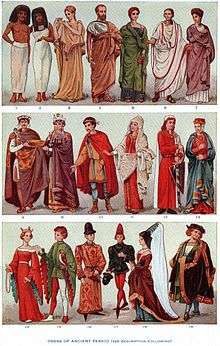Sompot
The Sompot (សំពត់, ALA-LC: saṃbát, IPA: [sɑmpʊət]), a long, rectangular cloth worn around the lower body, is a traditional dress in Cambodia.[1] It can be draped and folded in several different ways. The traditional dress is similar to the dhoti of Southern Asia. It is also worn in the neighboring countries of Laos and Thailand where it is known as pha nung (Thai: ผ้านุ่ง, pronounced [pʰâː nûŋ]).[2]
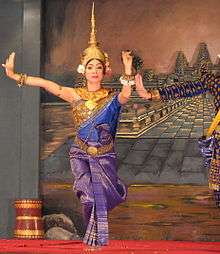
Origins
The Sompot dates back to the Funan era when a Cambodian king ordered the people of his kingdom to wear the Sompot at the request of Chinese envoys.[3] It is similar to the lungi and dhoti worn in the Indian subcontinent, the longyi worn in Burma, and the sarong worn in maritime Southeast Asia. Silk weaving was an important part of Cambodia's cultural past. People from Takéo Province have woven silk since the Funan era and records, bas-reliefs, and Zhou Daguan's report have shown that looms were used to weave sompots since ancient times.[3] Complex methods and intricate patterns have been developed to make the cloth, one of which is the hol method which involves dyeing patterns on silk before weaving. What remains unique to Cambodian weavers is the uneven twill technique. The reason they adopted such an unusual method remains unclear.[4] However, little is known about the old Khmer vocabulary for these fabrics, and if the sompot today was simply changed over time from the original Angkorian textiles. The ancient bas-reliefs however provide a complete look at what fabrics were like, down to patterns and pleats. Silk woven cloths are used in weddings and funerals and for decoration of temples.[5]
- Khmer deity wearing sompot samloy, Guimet Museum
 9-10th century Khmer female deities wearing other design of sompot. Guimet Museum
9-10th century Khmer female deities wearing other design of sompot. Guimet Museum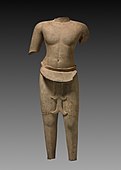 10th century Khmer male deity wearing sompot. Cleveland Museum of Art
10th century Khmer male deity wearing sompot. Cleveland Museum of Art- Devatas dressed in sompot tep apsara
Textiles
There are three important silk textiles in Cambodia. They include the ikat silks (chong kiet in Khmer), or hol, the twill-patterned silks and the weft ikat textiles. Patterns are made by tying natural and synthetic fibers on the weft threads and then it is dyed. It is repeated for different colors until the patterns firm and cloth is woven. Traditionally, five colors are used, predominantly red, yellow, green, blue and black. The Sompot Hol is used as a lower garment and as the sompot chang kben. The Pidan Hol is used as a ceremonial hanging used for religious purposes.
Variations
There are many variations of the sompot, each is worn according to class. The typical regular sompot, known also as the sarong is typically worn by men and women of lower class. It measures approximately one and a half meters and both ends are sewn together. It is tied to secure it on the waist.
- The Sompot Phamuong (សំពត់ផាមួង ALA-LC: saṃbát phā muaṅ) are many different variations of traditional Khmer textiles. They are single colored and twill woven. There are currently 52 colors used in Sompot Phamuong. The Phamuong Chorabap is a luxurious fabric using up to 22 needles to create. Phamuong variation are rabak, chorcung, anlounh, kaneiv and bantok. It usually uses floral and geometric motifs. The most valued silk used to create the Phamuong is Cambodian yellow silk, known for its fine quality in the region. New designs draw inspiration from ancient patterns on old silk.
- The Sompot Hol (សំពត់ហូល ALA-LC: saṃbát hūl) is a typical traditional textile. There are two kinds of Sompot Hol, one is a wrapping skirt that uses a technique called chong kiet and twill weave. Influenced by the Indian patola, it developed patterns and techniques over the centuries to become a genuine Khmer art style. The sompot hol has over 200 patterns combined with three to five colors, yellow, red, brown, blue, and green. There are four variations, sompot hol, sompot hol por, sompot hol kben, and sompot hol ktong. Patterns are usually geometric motifs, animals, and flower motifs.
In daily life
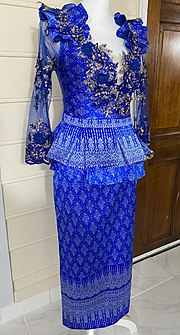
The sompot is deeply rooted in Cambodia. Even though the French brought a degree of Westernization to Cambodia, Cambodians continued to wear the sompot. Royalty and government officials used the sompot chong kben with a formal jacket. The sompot chong kben and sompot phamuong are still worn by Cambodians today during special occasions, and rural and poor Khmers still prefer it over Western-style clothing for its comfort. The material used by poor and rural Cambodians is not hand-woven silk but printed batik-patterned cloth imported from Indonesia. It is still popular with both men and women alike and is regarded by the people of Cambodia as their national garment.
See also
- Khmer Traditional Dress
- Cambodian clothing
- Culture of Cambodia
- Culture of Thailand
- Sompot Samloy
- Longyi
- Lungi
- Malong
- Patadyong
- Sarong
- Sinh
Further reading
- Gillian Green (2003). Traditional textiles of Cambodia. Bangkok: River Books. ISBN 974-8225-39-9.
References
- Emma C. Bunker, Douglas Latchford. Adoration and glory: the golden age of Khmer art. Art Media Resources, 2004, p. 35
- James C. Ingram. Economic change in Thailand 1850-1970. Stanford University Press, 1971, p. 10 By
- Green, Gillian. "Textiles at the Khmer Court". Arts of Asia 30 (4): 82–92.
- Textiles of the Highland Peoples of Burma, Vol. 2: The Northern Mon-Khmer, Rawang, Upland Burmish, Lolo, Karen, Tai, and Hmong-Mien-Speaking Groups, 2005. Michael C. Howard. White Lotus Co Ltd., ISBN 978-9744800749
- Joachim Schliesinger. Ethnic Groups of Cambodia Vol 2: Profile of Austro-Asiatic-Speaking Peoples. 312 pag. ISBN 163-3232379, ISBN 978-1633232372
External links
| Wikimedia Commons has media related to Sampot. |
